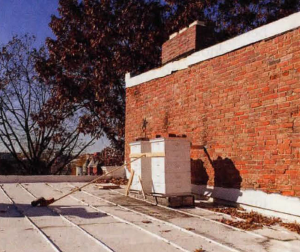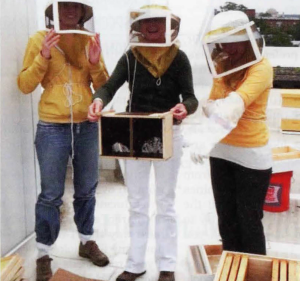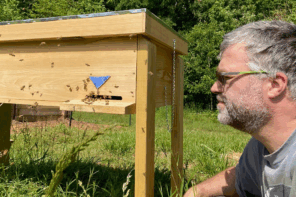By: Toni Burnham
This article appeared in the Winter 2016 issue of BEEKeeping Your First Three Years
Rooftop apiaries are probably the signature image of urban beekeeping. Downtown, we are often short on personal space, and long on neighbors, but the sky is wide open. City rooftops have surprising benefits for both bees and their minders, though like every other hive site, local features will have a lot to do with both upside and downside of skyside beekeeping.
There is one major advantage to urban roofs that needs to be mentioned right away: despite any concerns we may cover here, the presence of large, increasingly green city rooftops means that almost any urban dweller should be able to find a safe and healthy place to partner up with Apis mellifera!
In fact, I am a beekeeper because of the rooftop paradise we encountered when we moved here. Our roof has a flat deck, and you reach it via a spiral staircase to a level where the bees are looking straight at trees and not at frightened humans. My roof practically demanded that I take up beekeeping. To be fair, you may have to convince yours.
Looking at the upside of rooftop beekeeping, many rooftops greatly reduce neighbor and vandalism concerns, and there are some pests which don’t seem to do as well a story or so above ground. On the downside, beekeeper access can be difficult or even dangerous, hive moves achieve new dimensions in complexity, and wind has a whole new role to play. Luckily, others have come before us to tackle some of these problems, and we can look at a few cases here.
And a disclaimer: Nature being the way she is, you are likely to encounter variables not covered in this article, but here’s my “Top Ten List” of issues which potential urban rooftop beekeepers should consider up front.
Number One: Access
As important as the bees are, your beekeeping plans have to start out with how you are going to get all the pieces into place, and how are you are going to manage to take care of them and yourself over the long haul. History shows that stairs, hatches, and ladders can quickly turn into a very long haul. Also, many rooftop beekeepers share their roof with other tenants, or may even have an out apiary on a roof that does not belong to them. In many cities, beekeepers have hives on publicly owned buildings like community and recreation centers, and it is not unusual for a business (especially a hotel or restaurant) to solicit a beekeeper to place colonies on their premises. These hive hosts, however, may impose access rules or restrictions that you have to take in to account in your management plans.
Getting Established
You can set up a rooftop hive several ways, fortunately. And don’t be foolish: never attempt heavy maneuvers at altitude alone.
If you have access via a wide opening like a doorway or a bulkhead, you can move a nuc or split relatively easily, and can bring fully constructed hive components via additional trips. Many of us are lucky enough to have stairs leading up to a roof door or hatch, but it is possible to lift complete components up a sturdy enough ladder (preferably angled and with good treads to avoid slippage).
At the Trinidad Rec Center, we used a high quality hand truck with good thick rubber tires to set up the apiary there. We lashed a three-medium hive (secured with staples) to the body of the cart and lift/rolled it up a ladder, rung by rung, from above and below through a hatch used by the HVAC people when they move components. Remember, if your roof has large equipment on it that someone repairs, it is worth your while to get to know the maintenance team and learn how he or she gets the job done.
After this adventure, my co-conspirator Del Voss used his ex-Iowa farm boy expertise to build a Hive Crane from parts in farm implement catalogs. His crane can be secured on a roof with cement blocks and can lift a small hive a couple of stories. (He also uses the thing to lift mature hives off of rickety stands so the latter can be reinforced or replaced – my hero!)
When the hatch is small
Most of the townhomes in this city do not have full sized doors or hatches for roof access. In these cases, beekeepers often carry up unassembled hive parts up and hammer them together on site. Packages are easy to carry up and install, nucs a little more tricky. Just remember, for harvests, splits and hive moving purposes, what goes up must come down! We have hints about this later.
Tools and feeding
Most beekeepers end up carrying loads of stuff around with them as they tend their hives, and running to get a missing tool, or making separate trips for sacks of sugar or buckets of water have a whole new meaning when a hatch and a ladder and several flights of stairs lie between you and your kit.
Beekeepers need all that stuff. One of my favorite early beekeeping stories comes from the Montgomery County Beekeepers 2005 Field Day. Several experienced beeks were taking a few dozen newbees through our first hive inspections when a swarm landed 40 feet up a tree in the same apiary. Before you know it, middle-aged beeks in veils were running to their cars, one grabbed a saw, another a hundred feet of rope, someone had bed sheets, one an empty nuc box, and another was up that tree before the car folks got back. They got the swarm, but I got the impression that they were absolutely nuts.
However, today my car contains, among other things, just about everything you need to take down a bee tree. Beekeeping is like that. How are you going to guarantee access to all the stuff you need when you are a couple (or more) stories up?
At most of our rooftop apiaries, we either request storage space in a nearby stairwell or place a waterproof plastic container (secured with bricks, bungee cords, or both) with a minimum set of two hive tools of different types, a bee brush, entrance reducers, note pad, pen, smoker, fuel, lighters, hat veil, gloves, and a sealed white plastic HDPE bucket with a bag of dry cane sugar inside. Some sites keep complete jacket veils on site, but if the public has access, those can be expensive to lose. We also post a “Warning: Apiary” type of sign within 20 feet of the hives.
We are lucky in that many of our roof sites have working hose nozzles, and that some folks have rigged a hose up the back of the house. If not, you will have to haul your own H2O up there. Use the plastic bucket for mixing food on site (if robbing is not an issue at the time). And keep in mind a water source for your bees!
Case Study One: The Less-Than-Perfect Roof
 Matt Braun started his third year as a rooftop beekeeper in 2012, and his hives are on the roof of a row house on Capitol Hill. They’re about 2.5 stories up, though his neighbor’s house is one story taller and provides a decent windbreak.
Matt Braun started his third year as a rooftop beekeeper in 2012, and his hives are on the roof of a row house on Capitol Hill. They’re about 2.5 stories up, though his neighbor’s house is one story taller and provides a decent windbreak.
Matt has a slightly slanted, antique tin roof with ridges and a small wooden hatch in the ceiling of his spare bedroom, similar to the photo here. Matt finds that being on the roof adds a bunch of complications that terrestrial beekeepers don’t have to worry about. In no particular order, here are some things that he’s spent a lot of time thinking about:
1. As his wife likes to point out, the roof structure and the surface are designed to keep weather and water out, and not to hold hundreds of pounds of bee hives, and more importantly, to hold up to foot traffic. Some roofs are certainly sturdier than others: his is 86 years old. Matt occasionally lies awake at night in bed staring up at the ceiling, wondering if the roof is about to give way, and 60,000 startled honey bees are going to come pouring through the roof. Realistically this probably isn’t too much of a worry, but leaks are. Water damage from even a small leak could cost a small fortune and ruin your relationship with fellow residents (or the landlord). So, you have to be confident that the roof is going to hold up, and you should be vigilant about inspecting for damage, recoating more often than is the norm, and minimizing the number of extra people you take up there for show and tell.
2. On a similar note, I recommend a hive stand that spreads the load out, preferably perpendicular to the direction of the joists. This could be a pain with the metal ridges, and if the roof isn’t flat. Matt cut 2x8s on an angle and ran them parallel for ~8 feet. You’re probably planning on one hive, but spend a lot of time thinking about your stand, and make it from day one with space for at least three hives. When you’re standing on the roof with a recently collected swarm in a burlap sack and need a place to dump them you’ll be glad you planned ahead.
3. Invent a system where by the screen bottom board isn’t dumping directly onto the roof coating. Lots of wax/propolis/crap builds up down there and it makes it harder to keep on eye on the roof itself underneath.
4. Matt’s hives originally were not strapped down in any way – the telescoping covers had two bricks on top, and that was it. For about 24 months, that was fine. Since then, he recommends building a strapping system into your hive stand, especially it you’re higher up and more exposed. If a heavily laden hive fell in strong winds, it could easily punch a hole in the metal roof. Also, if something goes wrong, you’ll likely only figure it out on your next inspection since you don’t see the hive every day like you would in your yard: the stakes are a bit higher. The rational engineer in Matt didn’t think he needed straps at the beginning, but his emotional human side concluded that he’d sleep better through Super storm Sandy with them, so he added them this Summer. And the hives did fine!
5. Carrying things up and down through the hatch is a pain. When you forget something and have to run back down it’s a hassle. If you can leave tools on the roof in a plastic tub (also strapped down so it doesn’t fly away), it’ll save you a lot of suffering. Similarly, maneuvering through the hatch and down a ladder carrying a 10 frame medium super full of capped honey is really difficult/dangerous (31 year old male in reasonably good shape here). I won’t be doing that again. I’m building some boxes to carry four or five frames at a time.
Matt’s bees haven’t had any problems from the hottest Summer days or the windiest Winter nights. He says that all new beekeepers seem to worry about those things, but in practice they are rarely problems.
Matt’s advice basically comes down to plan really well before you bring a colony home. Everything is more logistically challenging on the roof. He promises that you won’t regret spending extra time working out as many details ahead of time as possible. Do whatever it takes to ensure your peace of mind on the windiest stormy night.
Case Study Two: Out Apiaries, or “What if it’s not your roof?”
If your bees are not located on a roof which you own, you have special responsibilities and potential liabilities to other, non-beekeepers, as well as the chance to keep bees in locations that may be healthier than the limiting hive site options in tiny ground level yards.
For many urban beekeepers, their first hive is not going to be located in the same place they are living, especially for those in apartments or condos, or in rented accommodations. Many beekeepers are able to find public beekeeping programs at gardens or recreations centers, or are invited to place their hives at businesses such as hotels or restaurants, or even at their employers.
In many cities, building LEED-certified green buildings (with green roofs!) is the norm, and beekeepers are finding it relatively easy to pitch beekeeping to organizations that are already
making these investments.
The opportunity is there, but it is always wise to weigh it against risks and responsibilities. And it is a good idea to get them spelled out in advance – key contacts, access times and means, on site storage, core responsibilities, what happens in case of damage, and what arrangements are necessary for exiting or expanding the apiary, among others. Look online for sample agreements related to public beekeeping, and consider adapting them for your apiary’s needs!
 In 2009, Izzy Hill, Chloe Wardropper, Rebecca Davis, and Gretchen Anderson launched an apiary that has since grown to three thriving hives on the roof of a community center in the most densely populated part of their city. They got help from, and volunteer for, a beekeeping education project sponsored by the Parks Department and Whole Foods.
In 2009, Izzy Hill, Chloe Wardropper, Rebecca Davis, and Gretchen Anderson launched an apiary that has since grown to three thriving hives on the roof of a community center in the most densely populated part of their city. They got help from, and volunteer for, a beekeeping education project sponsored by the Parks Department and Whole Foods.
There were strings attached with the offer of this apiary. The new beekeepers were expected to help care for publicly owned hives in the same apiary, and to participate in education and outreach programs involving both of the sponsors. Located above playing fields and fountains, they were also expected to keep an eye on swarms, robbing, and the need for water. Finally, they had no access to the apiary on Sunday at all, and could only get nighttime or early morning access with special assistance, arranged for in advance, from official staff members.
Sundays have developed into nail biters. Several major windstorms and blizzards have pelted DC on Saturday nights over the past three years, with hives located five stories up and wind barriers only on one side. The beekeepers made it through the first storm with no damage, and quickly ferried large cement blocks up to the roof and placed them on tele covers. Thus far, snow loads have not blocked lower entrances, but the beekeepers maintain upper entries just in case.
The Spring of 2012 was also a rare one for swarms in Washington, DC, and Izzy and Rebecca’s hive popped out a monster, which attached itself to a tree trunk next to a very popular basketball court. Luckily, a history of close communication with not only the key staff member but also the front desk and the maintenance staff (and just about anyone in the building who showed the least curiosity) resulted in a quick phone call to an available beekeeper, as well as an invitation to bystanders to watch the swarm get hived from a safe distance and learn more about honey bee behavior and the environmental strength of their neighborhood.
Because everyone knew about the bees, knew who to call, and saw what a quick and informative response they could get, the program only got stronger.
When key collaborating staff left the Park department, it became important to seek out and develop a new relationship with her successor, who might not share the same interest in public beekeeping! Thus far, that request has come in the form of a greatly ramped up public education schedule, which is a challenge for such a small team of beekeepers. The next stage is to sit down and negotiate a clearly spelled out set of responsibilities and guarantees by both parties – something missing before now – including emergency contact plans as well as some scenarios for current
participants exiting and others entering the project as needs change.
Just recently, the beekeepers harvested three supers of honey from this apiary, with several bottles designated for the public hearing on the broader legalization of beekeeping now just passed. Their efforts have been a key component in making these steps forward possible, in part because keeping bees on someone else’s roof inevitably leads to talking about bees with people who would never have encountered them any other way!
Number Two: Beekeeper Safety
While it’s a shame if an apiary does not work out for the bees, it’s a tragedy if it causes harm to the beekeeper. Call it common sense, but look after yourself first when you are running around a story or more above grade.
Factoring in everything we said about access, remember that a fall or a back injury from hefting yourself or your tools and hive parts onto roofs ups the ante considerably. Take it slow. Take several trips, rather than rushing it all into one or two. Bring a buddy with you as often as you can when tending a rooftop apiary, and failing that, bring a well-charged cell phone. Keep it within reach.
Your bees are not the only ones who need water up there: during the Summer, you will, too. I put a weather station up next to my hives the same year they were installed, and discovered that Summer temperatures were routinely five to 10° F higher on the roof than on the ground, with less shade. Too many beekeepers let themselves get dehydrated in the average Summer beeyard: dizziness brings an additional hazard at elevation.
Throughout the year, we’ve recorded roof wind speeds that were not as high as the airport, but much higher than at ground level. Don’t leave a lot of loose stuff (buckets, feeders, bottom board inserts, dead frames, etc.) laying around for you to trip on or to blow into your or a neighboring yard.
Finally, site your hives well away from roof edges, and let the bees fend for themselves during thunderstorms, hurricanes, and tornados. Even if they get toppled, they have handled worse, but you probably haven’t.
Number Three: Honey Bee Health and Safety
Roofs are actually fairly groovy places to be a bee. Dr. Tom Seeley tells us that they would prefer to be at least 40 feet up in a tree anyway, and in places where trees are their main forage, rooftops are like front row seats.
Nonetheless, some roofs hold unnatural hazards for honey bees. Mine has air conditioning units and satellite dishes, bigger buildings have all this at a far larger scale, with additional ventilators for things like kitchens and furnaces and labs that may not be honey bee friendly.
If you have a choice, try to site your bees far from any roof edge, but also a good distance from machines that vibrate or blow fumes. Windbreaks make all the difference in long term hive vitality, and you can try to provide one (shrubs, cement blocks, hay bales) if you want to experiment.
On your initial site survey, keep an eye out for equipment that leaks (especially air conditioners) or other pools of suspicious liquid that might prove tempting to a thirsty bee. Make sure there is something better, like a really murky tray of algae filled water that you provided, if you think this might be an issue.
Some beekeepers have reported that pools and fountains have created honey bee problems, for different reasons. Fountains that run all Winter do that by using antifreeze – hazardous to bees as well as family pets – and some of the more luxurious apartments or hotels have them.
On the benefit side, it appears that pests like Small Hive Beetle have a relatively harder time completing their life cycles on roofs (though they can continue to fly in) and Varroa and wax moths are rumored to struggle a bit more in this more highly ventilated environment. Bees in North America do not seem to mind the hotter and colder temperatures, though I have used fans that help cool the hives on the hottest days.
Number Four: Structural Safety
If your potential rooftop apiary is on a private residence or an older public building it pays to have a look at, and account for, the structural strengths and weaknesses of the roof.
My roofer advised me to place my hives as close to the bearing walls as possible, and directly over roof joists that he identified for me. For townhomes, bearing walls are often the party walls between units, and they often jut above roof surfaces. This provides a double benefit of a windbreak and visual barrier from neighboring structures.
He also provided me with a protective roof walkway pad that I could place over the roof membrane itself in the places I would be traversing most frequently. These are available online in 30′ rolls – consider splitting one with a friend.
It might not be a bad idea to use a skid proof pad here, too.
Try to watch the loads placed on your roof by numbers of visitors or the kinds of activities you undertake up there. I once terrified a fellow beekeeper by jumping around on his antique roof, trying to dislodge a swarm from an overhanging tree branch. Duh.
Educate yourself about the strengths and weaknesses of the roof surface you have been dealt. I found out the hard way that I needed to be more careful where I put down my lit smoker. Prepare to be honest with yourself if your roof needs significant repair before it can take on such a role, or if it’s just not the right place for your or your bees.
Number 5: Neighbors, Vandals and Other Third Parties.
Probably the main benefit of urban rooftop beekeeping is the extraordinary solitude and separation from the ground level hubbub it brings, but even here other people do play a role. In the city, there is a strong statistical likelihood that you will run into someone who does not want bees and does not want to hear about it. Roof apiaries tilt the odds in the bees’ direction!
Hiding in plain sight is just good policy for a home apiary in dense environments. It means that the people paying attention to your bees are more likely to be on the lookout for them because they appreciate them. While I am lousy at keeping them secret (I write about bees in magazines, for example) about half of my neighbors still have no idea what I am doing up there. And we are both happier that way. My apiary is visible from an apartment building about a block away, so I painted the hive bodies the same color as the trim of my house. Most times, I think the hives look like additional HVAC gear.
We have had sad conflicts where rooftop beekeepers here have had to remove hives in adverse conditions due to neighbor threats and complaints, and I do believe this could happen to anyone. The roof can protect you from a lot, but not from stupid or angry. You can do a lot to prevent the latter with good hive management, but there is no cure for the former. Try to manage your risk by lowering your profile and figuring out, in advance, with whom you are going to share.
Rooftop vandalism is rare, but if other people use the roof, make sure you post a sign that indicates that the bees are there, and that they are beneficial, but that unauthorized visitors place themselves at risk.
It is a good idea to communicate in advance with other roof users to prevent inadvertent interactions, and to build channels of communication that might come in handy if a swarm emerges or a weather event or accident topples your hive.
In summary, if it’s your roof, it’s your business, but if you are sharing premises, be prepared to share information and expectations.










